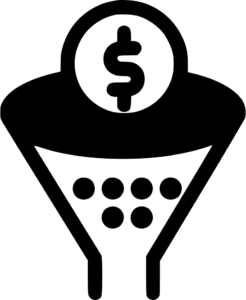CONVERSIONS UNRAVELED: DECIPHERING THE ART OF TURNING A STRANGER INTO A CLIENT
In the world of Digital Marketing, conversions are the lifeblood of success. They are the moments when a visitor becomes a customer, an observer becomes an advocate, and a casual interest transforms into a tangible outcome. Understanding conversions is key to unlocking the true potential of your online presence. But fear not, for in this blog post, we’ll demystify conversions and explain them one step at a time!

WHAT ARE CONVERSIONS?
Conversions are the desired actions visitors take on your website, such as making a purchase, subscribing, or filling out a form. They indicate the effectiveness of your marketing efforts and the engagement of your audience. #ActionsSpeakLouderThanClicks
CONVERSION RATE:
The conversion rate is the percentage of visitors who complete a desired action. It’s calculated by dividing the number of conversions by the total number of visitors and multiplying by 100. #CrackingTheConversionCode
CALL-TO-ACTION (CTA):
A CTA is a clear, compelling prompt that directs visitors to take a specific action. It’s a strategically placed element, usually in the form of a button or link, that encourages users to engage further with your website or marketing content. The purpose of a CTA is to guide visitors towards conversions by providing a simple and persuasive instruction.
CTAs are designed to grab attention, create a sense of urgency, and entice users to take immediate action. They often use action-oriented language, such as “Buy Now,” “Sign Up,” “Download,” or “Learn More.” The text and design of a CTA should stand out from the rest of the page, making it visually noticeable and enticing to click.
Effective CTAs should be relevant to the context and align with the goals of your website or marketing campaign. They should clearly communicate the value proposition and benefits of taking the desired action. A well-crafted CTA can significantly impact conversion rates by guiding visitors towards the next step in their customer journey.
When designing a CTA, consider factors such as placement, color, size, and wording. Test different variations to determine what resonates best with your target audience. Additionally, it’s essential to ensure that the CTA leads to a seamless and intuitive user experience, delivering on the promises made in the call-to-action itself.
Remember, a strong CTA has the power to transform passive observers into active participants, driving conversions and achieving your marketing objectives.
#DirectingTheDigitalTraffic

LANDING PAGE:

A landing page is a standalone web page designed specifically to capture visitor’s attention and encourage conversions. It is often created as part of a marketing campaign and focuses on a single objective, such as getting users to make a purchase, subscribe to a newsletter, fill out a form, or download a resource.
The primary goal of a landing page is to convert visitors into leads or customers. Unlike a typical website page that may have multiple purposes and navigation options, a landing page is streamlined and devoid of distractions. It is crafted to deliver a focused message and provide a clear call-to-action (CTA) that guides visitors towards the desired conversion.
Key elements of an effective landing page include:
- Compelling headline: The headline should grab the visitor’s attention and convey the value proposition or offer clearly and succinctly.
- Engaging content: The content on the landing page should be concise, persuasive, and highlight the benefits of taking the desired action. It should align with the visitor’s needs and provide relevant information.
- Visual elements: Images, videos, or graphics can be used to enhance the visual appeal of the landing page and communicate the message effectively. Visuals should support the main goal and be consistent with the overall branding.
- Clear call-to-action (CTA): The CTA should be prominent, well-designed, and use action-oriented language. It should clearly state the desired action and create a sense of urgency or motivation to act.
- Form or data capture: If the goal is to collect user information, a form is typically included on the landing page. The form should ask for necessary details without being too overwhelming, balancing the need for information with user convenience.
- Trust indicators: Testimonials, customer reviews, trust badges, or security seals can help establish credibility and build trust with visitors.
- Mobile optimization: With the increasing use of mobile devices, landing pages should be designed and optimized for a seamless mobile experience. Responsive design ensures that the page adapts to different screen sizes and devices.
- A/B testing: It’s important to continuously test and optimize landing pages to improve conversion rates. A/B testing involves creating multiple versions of the landing page and comparing their performance to determine the most effective design, content, or CTA.
By creating a well-designed landing page that aligns with your marketing goals and provides a compelling user experience, you can increase the likelihood of converting visitors into valuable leads or customers.
#FirstImpressionsMatter
A/B TESTING:
A/B testing, also known as split testing, is a method used to compare two different versions of a webpage, email, advertisement, or any other marketing asset to determine which version performs better in terms of achieving a specific goal, such as increasing conversions, click-through rates, or engagement.
The process of A/B testing involves creating two variations of the marketing asset: Version A (the control) and Version B (the variation). The two versions are identical except for a single element that is changed in Version B, which is the element being tested. This element can be anything from a headline, button color, layout, image, or even the entire design.
The two versions are then randomly shown to an equal number of users or visitors, and their responses and behaviors are measured and compared. Metrics such as click-through rates, conversion rates, bounce rates, time on page, or any other relevant data are analyzed to determine which version performs better.
The key steps in conducting an A/B test are as follows:
- Identify the goal: Clearly define the specific goal or metric you want to improve, such as increasing sign-ups or improving click-through rates.
- Choose the element to test: Select a single element that you believe might have an impact on the desired goal. It should be something that can be easily changed and measured.
- Create variations: Develop two versions of the marketing asset: the control version (A) and the variation (B). Ensure that only one element is changed between the two versions.
- Split the traffic: Randomly divide the incoming traffic or users into two equal groups, with each group seeing either Version A or Version B.
- Gather data and analyze results: Measure the performance of each version using relevant metrics. Analyze the data to determine which version outperformed the other and achieved the desired goal.
- Implement the winning version: Once you have determined the version that performed better, implement it as the new default or continue iterating and testing further.
A/B testing helps eliminate guesswork and make data-driven decisions. It allows marketers to understand how changes to specific elements impact user behavior and outcomes. By continuously testing and optimizing marketing assets based on real user data, businesses can refine their strategies and improve their overall marketing performance.
Remember, A/B testing is an iterative process, and it’s important to test one element at a time to accurately attribute any changes in performance to the specific variation being tested.
#TestingTheWaters
CONVERSION FUNNEL:

A conversion funnel, also known as a sales funnel, is a visual representation of the stages that a potential customer goes through on their journey from initial awareness to final conversion or purchase. It outlines the steps a user takes, starting from the moment they become aware of a product or service, progressing through various decision-making stages, and culminating in the desired action or conversion.
The conversion funnel typically consists of the following stages:
- Awareness: This is the top of the funnel, where potential customers become aware of your brand, product, or service. They may come across your website, see an advertisement, or receive a referral. The goal at this stage is to attract attention and generate interest.
- Interest/Consideration: In this stage, potential customers are actively considering your offering. They are evaluating its relevance, value, and how it meets their needs or solves their problems. Providing detailed information, testimonials, case studies, and comparisons can help nurture their interest and move them closer to conversion.
- Evaluation/Decision: At this stage, potential customers are comparing options and making a decision. They may be reviewing pricing, features, reviews, or seeking additional information to finalize their choice. Offering incentives, discounts, or free trials can help push them towards the decision to convert.
- Action/Conversion: This is the final stage of the funnel where the potential customer takes the desired action, such as making a purchase, filling out a form, signing up for a newsletter, or subscribing to a service. The conversion indicates that the customer has successfully moved through the funnel and completed the desired goal.
It’s important to note that not all potential customers will make it through the entire funnel. Some may drop off at any stage due to various reasons, such as lack of interest, finding a better alternative, or encountering barriers in the process. Understanding the conversion funnel helps businesses identify areas where potential customers are dropping off and take steps to optimize those stages to improve conversion rates.
By analyzing the data at each stage of the funnel and making targeted improvements, businesses can optimize their marketing efforts, refine their messaging, address customer concerns, and provide a seamless user experience. This iterative process helps to guide potential customers smoothly through the funnel and maximize the chances of conversion.
#GuidingVisitorsToVictory
CONVERSION OPTIMIZATION:

Conversion optimization, also known as conversion rate optimization (CRO), is the process of systematically improving the performance of a website, landing page, or marketing campaign with the goal of increasing the conversion rate. It involves analyzing data, making targeted changes, and continuously testing and refining strategies to optimize the user experience and drive more desired actions from visitors.
The key steps involved in conversion optimization are as follows:
- Define goals: Clearly identify the specific goals or desired actions you want visitors to take on your website or landing page. This could be making a purchase, signing up for a newsletter, downloading a resource, or any other conversion metric that aligns with your business objectives.
- Collect data: Gather quantitative and qualitative data about user behavior, traffic sources, user demographics, and other relevant metrics. This can be done through tools like Google Analytics, heatmaps, user recordings, surveys, or feedback forms. Data analysis helps identify patterns, trends, and areas for improvement.
- Identify areas for optimization: Analyze the data to identify potential barriers, friction points, or elements that may be impacting the conversion rate negatively. This could include issues with page load times, confusing navigation, unclear messaging, or lack of trust signals.
- Develop hypotheses: Based on the data analysis, generate hypotheses or assumptions about the changes that could positively impact conversions. For example, changing the CTA color, simplifying the form, or improving the headline may lead to better results. Prioritize the hypotheses based on potential impact and ease of implementation.
- Implement changes: Make the necessary modifications to your website or landing page based on the prioritized hypotheses. Ensure that the changes align with best practices, usability principles, and the overall user experience.
- A/B testing: Test the variations of the modified elements using A/B testing. Create multiple versions of the webpage or specific elements and randomly split the traffic to compare their performance. Monitor and measure the results to determine which variation drives higher conversions.
- Iterate and refine: Analyze the test results and draw insights from the data. Learn from the successful variations and implement the changes that resulted in better conversion rates. Iterate and repeat the process by continuously testing new ideas and refining your optimization strategies.
- User experience optimization: Besides testing specific elements, it’s crucial to focus on overall user experience optimization. This involves ensuring a seamless, intuitive, and user-friendly journey throughout the conversion process. Pay attention to page speed, mobile responsiveness, clear messaging, intuitive navigation, and persuasive content.
Conversion optimization is an ongoing process that requires constant monitoring, testing, and refinement. By continuously analyzing data, experimenting with changes, and focusing on improving the user experience, businesses can increase conversion rates, maximize the return on investment (ROI) of their marketing efforts, and ultimately achieve their business objectives.
#OptimizingForSuccess
MICRO-CONVERSIONS:
Micro-conversions are smaller actions or milestones that users take on a website or within a marketing funnel that indicate progress towards a larger conversion or end goal. These actions may not directly result in a final sale or ultimate conversion but serve as valuable steps in the customer journey and provide insights into user engagement and interest.
Some examples of micro-conversions include:
- Signing up for a newsletter: When a user subscribes to a newsletter, it shows an interest in receiving updates, content, or offers from the business. It allows the business to establish ongoing communication and nurture the relationship with the user.
- Adding items to a cart: In an e-commerce context, adding products to a shopping cart is a micro-conversion. It demonstrates an intent to make a purchase, and although it doesn’t guarantee a final sale, it indicates a higher level of engagement and interest compared to simply browsing.
- Creating an account: When a user registers or creates an account on a website, it shows a commitment to engage further with the platform. It provides the business with user information, allows for personalized experiences, and opens up opportunities for future conversions.
- Downloading a resource: If users willingly download a whitepaper, ebook, or other valuable content, it signifies an interest in learning more about a specific topic or acquiring knowledge. This micro-conversion can help build trust and establish the business as a reliable source of information.
- Watching a video or completing a video view: Video engagement can be considered a micro-conversion. When users actively watch a video related to a product, service, or educational content, it indicates their interest and investment in understanding more about the offering.
Micro-conversions are valuable because they provide insights into user behavior and preferences. Tracking and analyzing micro-conversions can help businesses identify points of engagement or potential drop-offs within the customer journey. It allows for targeted marketing efforts, personalized follow-ups, and optimization of the conversion funnel to drive users towards the final conversion.
By recognizing the significance of micro-conversions and leveraging them strategically, businesses can enhance user experiences, nurture relationships, and increase the likelihood of achieving the ultimate conversions they desire.
#SmallStepsBigResults
CONVERSION ATTRIBUTION:
Conversion attribution is the process of assigning credit or determining the contribution of various marketing channels, touchpoints, or interactions that lead to a conversion. It involves understanding which marketing efforts or actions played a role in influencing a user’s decision to convert.
In a multi-channel marketing landscape, customers often interact with multiple touchpoints before making a purchase or completing a desired action. Attribution helps marketers identify the most effective channels or campaigns, allocate resources optimally, and make data-driven decisions to optimize their marketing strategies.
There are several common attribution models used to assign credit for conversions. Some of the most widely used models include:
- Last Click/Last Interaction: This model attributes the entire credit for a conversion to the last touchpoint the user interacted with before converting. It assumes that the final touchpoint was the most influential in driving the conversion.
- First Click/First Interaction: In contrast to the last click model, this model attributes all the credit to the first touchpoint or channel that initiated the customer’s journey. It emphasizes the initial introduction and assumes that the first interaction had the most significant impact.
- Linear: The linear attribution model assigns equal credit to each touchpoint or interaction in the customer journey. It suggests that every touchpoint played an equal role in leading to the conversion.
- Time Decay: In this model, more credit is given to touchpoints that occurred closer in time to the conversion. It assumes that the more recent interactions had a higher influence on the decision-making process.
- U-Shaped: Also known as the position-based model, it assigns higher credit to the first and last interactions, while the rest of the credit is distributed evenly among the touchpoints in between. This model acknowledges both the initial engagement and the final conversion-driving touchpoint.
- Customized Models: Businesses may develop their own attribution models based on their specific goals, customer behavior, and industry. Custom models allow for more flexibility and reflect the unique characteristics of the business.
It’s important to note that attribution models are not one-size-fits-all solutions, and the choice of model depends on the business objectives, customer journey complexity, and available data. Often, a combination of models or data-driven approaches like machine learning and algorithmic attribution are employed for more accurate and granular attribution analysis.
Ultimately, conversion attribution helps marketers understand the effectiveness of their marketing efforts, allocate budgets effectively, optimize campaigns, and make informed decisions on resource allocation. By gaining insights into the impact of different touchpoints on conversions, businesses can refine their strategies to maximize their return on investment and drive better marketing performance.
#GivingCreditWhereIt’sDue
CONVERSION TRACKING:

Conversion tracking is a process used to measure and monitor the actions or conversions that occur as a result of a marketing campaign or user interaction. It involves tracking and recording specific events or behaviors that indicate successful conversions, such as a purchase, form submission, newsletter signup, or any other predefined goal.
The primary purpose of conversion tracking is to gain insights into the effectiveness of marketing efforts and determine which channels, campaigns, or strategies are driving the desired results. By tracking conversions, businesses can evaluate the return on investment (ROI) of their marketing activities, optimize campaigns, and make data-driven decisions to improve overall performance.
The process of conversion tracking typically involves the following steps:
- Define conversion goals: Clearly identify the specific actions or events that indicate a successful conversion. This could be a purchase, a lead generation form submission, app download, or any other action that aligns with your business objectives.
- Set up tracking mechanisms: Implement tracking codes or tags on your website, landing pages, or mobile apps to capture data about user interactions and conversions. This is typically done using analytics tools such as Google Analytics, Facebook Pixel, or other tracking platforms. Each conversion goal will require a unique tracking mechanism.
- Track user interactions: Once the tracking mechanisms are in place, the system will start collecting data about user behavior. It tracks when conversions occur, which marketing channels or campaigns led to the conversions, and other relevant data points.
- Analyze conversion data: Regularly analyze the conversion data to gain insights into the performance of your marketing efforts. Identify which channels, campaigns, or keywords are driving the most conversions. Assess the conversion rates, cost per conversion, and other metrics to understand the effectiveness of different marketing activities.
- Optimize campaigns: Use the insights from conversion tracking to optimize your marketing campaigns. Allocate budgets to the most effective channels, refine targeting, adjust messaging, or make other changes based on the data to improve conversion rates and overall campaign performance.
- Continuous monitoring and refinement: Conversion tracking is an ongoing process. Monitor and track conversions regularly to identify trends, spot areas for improvement, and make necessary adjustments to your marketing strategies. Test new approaches, experiment with different campaigns, and iterate based on the insights gained from the tracking data.
Conversion tracking allows businesses to measure the impact of their marketing efforts accurately. It provides valuable data that helps identify successful tactics, optimize campaigns, and make informed decisions to drive higher conversions and achieve business objectives. By tracking conversions, businesses can continuously improve their marketing strategies, allocate resources effectively, and maximize the return on investment.
#TrackingSuccess
Conversions might seem like complex beasts, but by breaking them down into bite-sized explanations, we’ve highlighted their significance and demystified the key concepts. With this newfound understanding, you can dive into the world of conversions and unleash the power of digital marketing to drive your business forward. Remember, conversion is one of the most important steps in the Digital Marketing process; it’s all about guiding visitors toward their desired outcomes, one action at a time.
#ConvertingTheDigitalRealm


